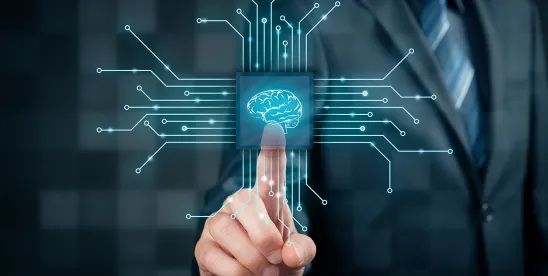It may seem that generative AI tools, such as AI chatbots, image and video generators, and coding agents recently appeared out of nowhere and astonished everyone with their highly advanced capabilities. However, the underlying technologies of these AI applications, such as various data classification and regression algorithms, artificial neural networks, machine learning models, and natural language processing techniques, to name a few, have been in development for over half a century. These technologies have been successfully implemented by companies across various science, technology and industry sectors for analyzing images and data, recognizing patterns, making predictions, optimizing and automating processes, machine translation and speech synthesis. In fact, hundreds of thousands of patents have been filed and granted worldwide by companies for inventions in various technical fields that incorporate innovative uses of AI.
Cybersecurity
US Patent No. 12,333,009 describes a system for detecting anomalies in computer processes using AI, specifically machine learning combined with Markov chains. The system monitors process execution, comparing events against a behavior model to calculate probabilities and identify anomalies. Machine learning models analyze event data to assess anomalous behavior, enhancing detection accuracy and efficiency. This approach allows for real-time identification of vulnerabilities and threats, overcoming limitations of traditional methods by leveraging AI to adapt to evolving cyber threats.
Cloud Computing
US Patent No. 12,033,002 discloses a system for scheduling program operations on cloud-based services using machine learning techniques. It involves breaking down program operations into sub-operations and matching them with suitable cloud service components, considering user constraints like budget and deadlines. The system uses machine learning to identify optimal service component combinations that meet user constraints while considering processing constraints. A scheduler then generates a cost-effective schedule for executing the operations, ensuring efficient use of cloud resources.
Fintech
US Patent No. 11,562,298 describes an AI-based predictive marketing platform that utilizes predictive analytics with first-party data from long-term conversion entities to optimize media content direction. The patented predictive analytics technique enhances conversion frequency and speed by employing machine learning algorithms to analyze online behavior data. The platform integrates online behavior with Customer Relationship Management (CRM) data to forecast conversion likelihood, facilitating more efficient ad targeting and campaign management.
Data Backup
US Patent No. 12,314,219 discloses a machine learning-based system for data archiving. The system collects statistical information and event data to classify data and predict access demands, effectively training itself to archive and extract data as needed. By identifying access patterns, the system adjusts threshold values for file access and assigns access classifications, enabling the migration of files between hot and cold data areas based on these classifications. This approach optimizes data storage and retrieval by leveraging machine learning to manage file access efficiently.
Networking
US Patent No. 11,966,500 describes a system for isolating private information in streamed data using machine learning techniques. Machine learning algorithms are employed to automatically identify and extract private information, such as facial images and license plate numbers, based on usage-specific rules. This extracted data is stored separately from the modified stream, which has the private information removed, ensuring privacy even if unauthorized access occurs. The system’s machine learning capabilities enable efficient and automated data management, adapting to various data types and usage scenarios to safeguard personal information.
Automotive
US Patent No. 10,579,883 describes a method for vehicle detection in intelligent driving systems using AI technology. It employs computer vision algorithms to process images from a monocular camera, identifying lane lines and determining a valid area for vehicle detection based on these lines and the vehicle’s speed. Machine learning, specifically weak classifiers, is used to detect vehicles within this valid area, optimizing processing efficiency by focusing only on relevant image sections. This approach reduces computational load and enhances the speed and accuracy of vehicle detection in driving assistance systems.
Health Care
US Patent No. 11,849,792 discloses a head-mounted device that leverages AI and machine learning to enhance the accuracy of monitoring a wearer’s physical conditions for heat stroke risk assessment. The device integrates sensors for salinity, humidity, body temperature, and heart rate, using AI to process data and predict potential heat stroke scenarios. Machine learning algorithms analyze the collected data to calculate sweating and salt loss, providing real-time insights and alerts. This intelligent system enables proactive management of heat-related risks, ensuring timely interventions to prevent severe health issues.
Telecommunications
US Patent No. 11,616,879 describes a system that uses machine learning to handle unwanted telephone calls, such as those involving fraud or spam. The system intercepts and records calls, converting the audio into digital information using an automatic speech recognizer. Machine learning algorithms analyze this data to classify calls as unwanted or genuine based on their content. The classification model is continuously trained and improved using user feedback, enhancing its ability to accurately identify and manage unwanted calls, thereby improving information security.
Computer Vision
US Patent No. 12,080,054 discloses a method for improving small object detection in images using machine learning, specifically neural networks. Conventional neural networks struggle with detecting small objects, but the proposed method restructures the network by shifting detection layers to earlier stages, where resolution is higher, enhancing the network’s ability to detect small objects without increasing input image size. This approach allows for real-time detection in applications like sports broadcasts, where small objects are identified quickly.
Biotech
US Patent No. 11,259,721 describes a method for noninvasively detecting total hemoglobin concentration in blood using AI technology. It involves determining a differential path factor based on physiological parameters and photoplethysmography (PPG) signals at two different wavelengths. Machine learning, specifically neural networks, is used to establish a relationship between physiological parameters and differential path factors, enhancing the accuracy of hemoglobin concentration measurements. This approach allows for precise, real-time monitoring of hemoglobin levels without the need for invasive blood sampling.
Industry
US Patent No. 12,182,700 discloses a method for improving fault diagnosis in blast furnaces using a deep neural network combined with decision trees. The approach leverages the high precision of deep neural networks to model historical fault data, converting this knowledge into understandable rules for operators. This method addresses the challenges of traditional expert systems and data-driven models by providing a more reliable and interpretable solution. The system enhances the automation and intelligence of iron-making processes, enabling effective human-machine collaboration and improving fault diagnosis accuracy in industrial applications.
Drones
US Patent No. 11,618,562 utilizes AI in the context of unmanned aerial vehicles (UAVs) to subdue targeted individuals. The system employs AI algorithms to analyze real-time data from the UAV’s sensors, enabling it to identify, track, and engage with target individuals autonomously. For example, machine learning is used to detect aggressive individuals based on gesture analysis. By leveraging machine learning and computer vision techniques, the UAV can make informed decisions about the most effective methods to subdue a target, ensuring precision and minimizing the risk of collateral damage.
Robotics
US Patent No. 11,297,755 describes a method for controlling soil-working machines, such as lawn mowers and harvesters, using AI technology, specifically convolutional neural networks (CNNs). These networks process images to create a synthetic descriptor of the soil, enabling machines to operate autonomously by recognizing soil characteristics and obstacles. The AI-driven system eliminates the need for external infrastructure like GPS or beacons, offering robust performance in dynamic environments with varying conditions. This approach enhances the machine’s ability to navigate and perform tasks efficiently, adapting to unexpected changes in the environment.
Resource Management
US Patent No. 12,242,996 discloses a system for managing schedule data by interpreting, detecting, and correcting schedule anomalies based on historical data. It includes components that interpret schedule data, identify violations of schedule norms, and generate corrective actions to adjust the schedule. Machine learning, particularly neural networks, is used to identify trends in historical data, which help establish schedule norms. The system can issue alerts or adjust parameters to ensure compliance with these norms, addressing issues such as excessive overtime or unfavorable shift patterns.




 />i
/>i


